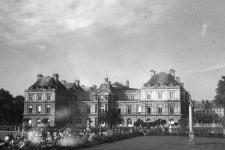|
Star Ajax (N° 11) |
Manufactured or assembled in United Kingdom from (Circa) 1933 to (After) 1935.
Index of rarity in France: Infrequent (among non-specialized garage sales)
Inventory number: 1083
See the complete technical specifications
Chronology of cameras Star
Coronet Camera was founded in 1926 in Birmingham, UK by Frederik John Pettifer. In 1932, he moved the company to 308-310 Summer Lane in the Aston district. In 1933, the company was renamed Coronet Limited. The production was significant, with 300,000 simple lenses being ordered from Taylor Taylor & Hobson in 1935!
Alongside the production of low-end cameras, such as box and folding cameras, F.J. Pettifer also manufactured cameras using colored Bakelite, with the help of neighboring company Edwin Elliott, which molded cameras and lenses for Coronet. Many of the cameras produced were "gift objects" or sold by mail-order companies.
During World War II, Coronet's workshops were destroyed by German bombings. Coronet was acquired in 1946 by Dufay-Chromax Limited and stopped all production around 1967.
The classification of Coronet folding cameras can be quite challenging, and I have often given up during the process due to the many uncertainties. What can be said about Coronet folding cameras is that they are film cameras, typically in the 6 x 9 format, made of metal, and generally feature simple technical characteristics.
There are versions referred to as "Automatic," recognizable by the shape of the bellows, meaning that the bellows and lens assembly automatically deploy when you open the camera's front cover. Other versions have the lens mounted on a carriage that needs to be manually pulled forward for setup. The latter type of cameras is the most basic.
The geographical origin of Coronet cameras is either English (Birmingham) or French, following agreements with Ph. Tiranty. The brand's logo, a crown, can be found on models manufactured in France.
Production spanned three decades with minimal changes. The earliest models can be identified by the film advance wheel, which was quickly replaced by a key due to its impracticality. The more recent models may have elements made of plastic (possibly bakelite). The last English models had a metal hood that incorporated the viewfinder and shutter release.
The lenses may bear a brand name, such as Taylor Hobson in the UK or Boyer in France, or they may be unbranded. Many models have simple meniscus lenses (single-element). A significant number of models have fixed focus.
"De Luxe" cameras appear in catalogs, but identifying them can be challenging as the "De Luxe" designation does not always appear on the camera itself. It appears that the "De Luxe" designation mainly involves more attractive covering and enameled paint on the sides. "Toutes Distances" (or TD) models are those without focusing capabilities.
Some models have well-defined names that appear either on the covering or the shutter. These names sometimes have a specific meaning, such as Diafilt (Diaphragm and Filter) or Hyperfo (adjustable to hyperfocal distance).
Coronet folding cameras disappeared at the end of the 1950s, becoming obsolete.
L'Ajax est bien un appareil fabriqué en Grande-Bretagne comme l'indique le "Made in England" du bouton d'avance du film, mais destiné (tout au moins ce modèle) au marché francophone, comme les mots "objectif", "mètres" le laissent penser. Ceci est confirmé par la présence de cet appareil au catalogue 1935 des appareils Star.
Il s'agit d'un bel appareil, bien fini. Les parties métalliques sont peintes d'une très belle laque noire. Le gainage est en cuir ou simili de couleur bleu-nuit. La face avant de l'obturateur est peinte en bleu-nuit.
Le système retenant l'abattant est similaire à celui des Coronet, mais contrairement à l'habitude, le nom de la marque n'apparaît pas.
Des recherches ont permis de découvrir que Spécialités Tiranty (importateur / distributeur de Coronet en France) avait déposé le 21 octobre 1937 (donc après le catalogue 1935 Star), au greffe du tribunal de commerce de la Seine (n°317056), la marque "Ajax" pour les appareils photographiques etc...
Tiranty nous relit à Coronet dont il fut importateur et distributeur pour la France, avant de fabriquer en région parisienne une partie des appareils vendus en France.
La forme des ciseaux et l'aspect général confirment la fabrication par Coronet.
Le rôle de Star est flou. S'agissait-il d'un simple revendeur ou bien présentait-il les appareils comme ceux de sa propre marque ?

Interesting links or bibliography :
Add a link or element of bibliography, a picture taken with this camera, a picture of box or an ads about this camera
Your photos taken with the same camera:

| 
|
Cameras from Ebay France (Star) (Uploaded each 3 hours)
 Appareil photo numerique Star Wars Lexibook - 5MP + Flash , neuf sous blister 10,00 euros Finira le 17-08-2024 à 20:00:01 |







